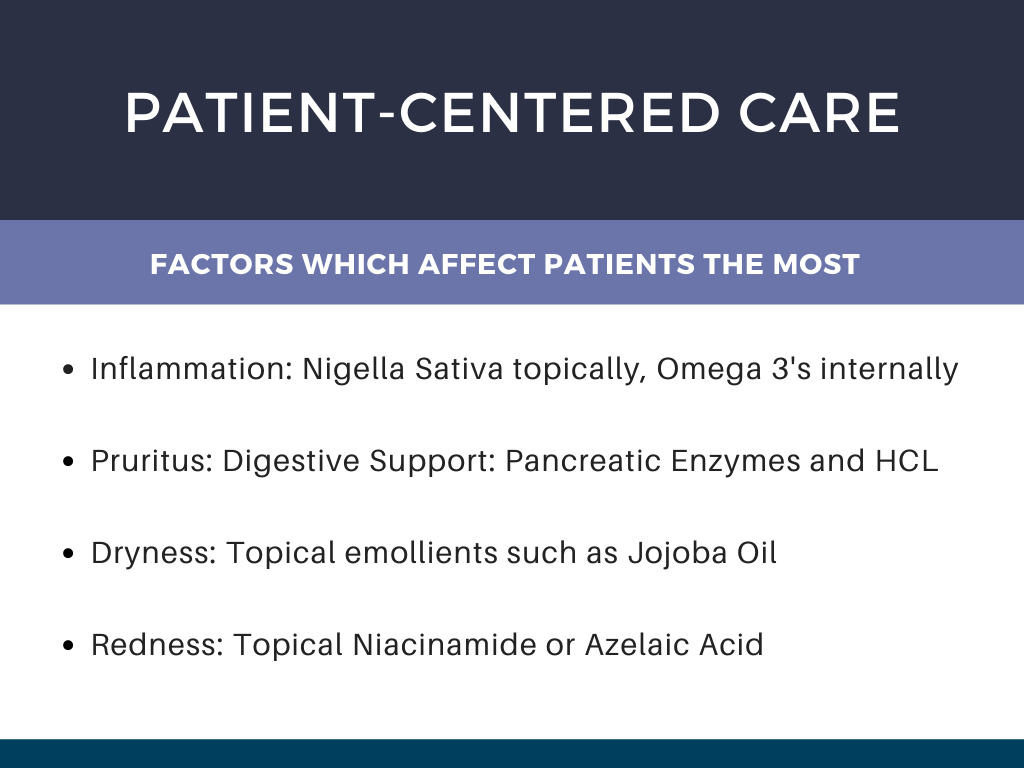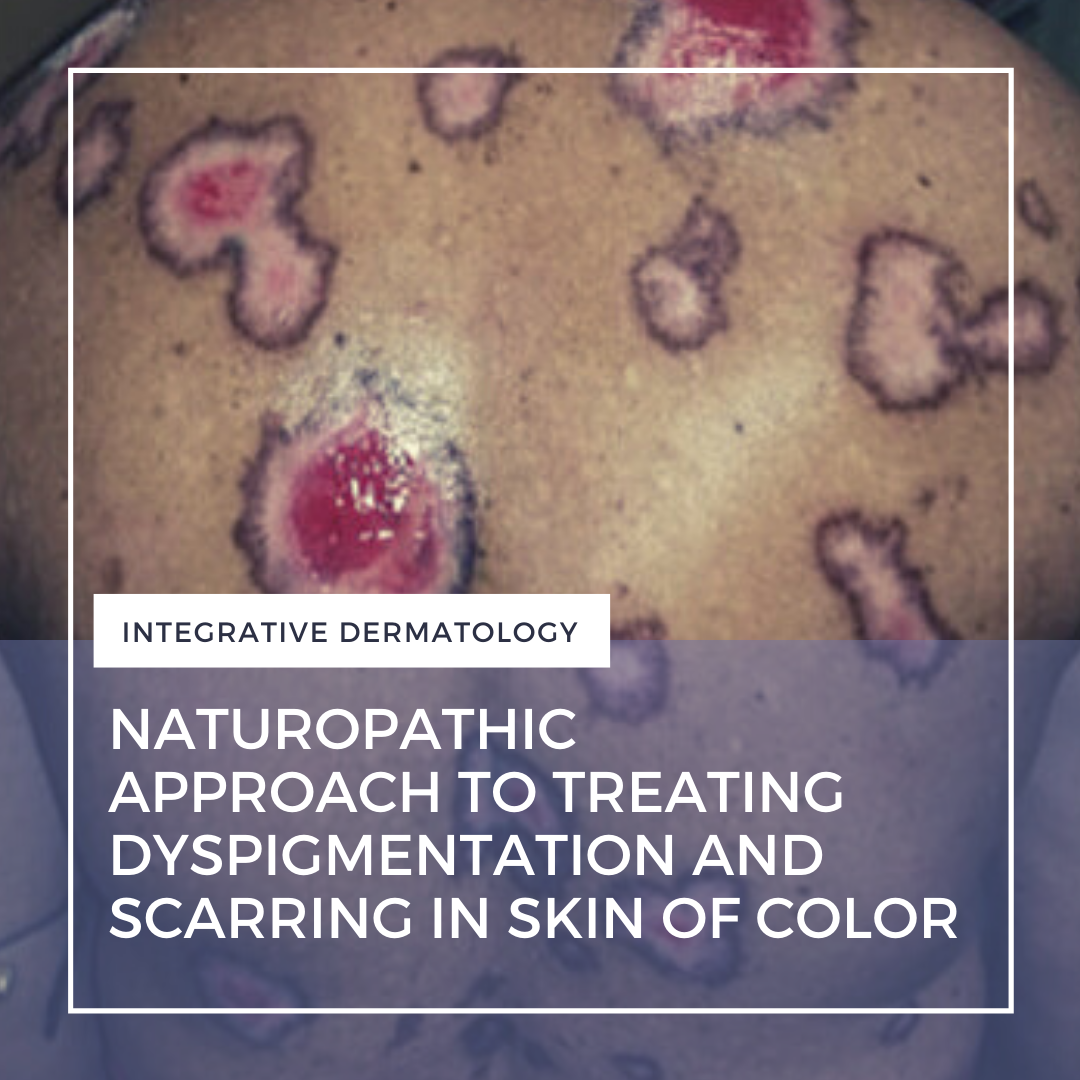As we know, people of color are more apt to have problems with dyspigmentation and excessive scarring (keloid formation and hypertrophic scars). We probably all use a combination approach for both of these: sun protection, peels, HQ, OTC skin lighteners, injections, lasers, energy-based devices, etc. These are common approaches, but what are the go-to’s for a naturopathic physician? You may need to add something to your own arsenal…
During the 2020 Integrative Dermatology Symposium, Dr. DeJarra Sims, ND shared her approach to the treatment of dyspigmentation and scarring. In her presentation, Ethno Dermatology: Naturopathic Approaches to Treating Skin Discoloration and Scarring In People of Color, she discussed many techniques you may need to think about adding to your practice.
This review will provide an overview of her talk, including:
-
- Specific treatment recommendations – both topical and oral supplementations
- Supportive evidence for use of the treatment approaches
Before we get into the full review, here are my “Ah-ha moments” – what I took away from the lecture that I found intriguing:
-
- You are already using naturopathic strategies! (Wait what? Yep!)
- Particular herbs contain active ingredients we already know and use (What herbs? See below!)
- Combination approaches work best (See summative chart below for examples)
A Quick Overview – Melanin and Scars
As we know, patients with skin of color have melanocytes that are more efficient and effective at producing melanin. Overproduction (epidermis) and/or pigment drop-down (dermis) lead to dyspigmentation concerns for patients. Darker skin types have a higher risk for post-inflammatory hyperpigmentation (PIH).
Scars are formed by deep enough, large enough, and long enough (time to wound healing) injury to the skin. We organize these scars into types: atrophic, hypertrophic, keloidal, hypopigmented, hyperpigmented, erythematous, etc. Early and aggressive intervention likely leads to the best outcomes.
Recommended Treatments
-
- Vitamin E – Dr. Sims typically has patients use this topically for scars and PIH
- Silicone – used as sheets or gels. Apply vitamin E and then cover with silicone scar sheet. Silicone likely works by hydration, compression, and decreased inflammatory response – scars
- Vitamin C – essential co-factor for collagen formation – Tissue anti-oxidant, reduced damage from UV damage by free-radicals, supports immune system – Maintenance with oral supplementation at 1-2 grams daily (may also use a higher dose for treatment dose) – can also be used topically for PIH and scars
- Vitamin A – supports the inflammatory phase of wound healing, epithelial cell differentiation, reduces hyperpigmentation. For scars and PIH – Oral supplementation 25,000 IU daily. Can also use topically.
- Nicotinamide – increases collagen synthesis and formation of keratin filaments, filaggrin, and involucrin. Dr. Sims presented a small study (n=27) – 4% nicotinamide vs 4% hydroquinone, split-face study, comparable results of reduction in hyperpigmentation at 8 weeks. She recommends 4% nicotinamide that she compounds with vitamin E for PIH.
- Allium Cepa (onion extract) – study presented that showed improved scar softness, redness, and texture – at 4,6 and 10-week assessments. Thought to be mediated by promotion of protein synthesis for scar treatment
- Rosehip oil – This comes from Rosa canina and Rosa rubiginosa This oil contains Vitamin C, Vitamin A, linoleic acid, linolenic acid, oleic acid, and trace amounts of retinoic acid. A study mentioned of post-surgical scars showed improvement in erythema, dyschromia, atrophy, and hypertrophy at 6 and 12 weeks compared to control – so can be used for scars and PIH.
- Jojoba seed oil – has high concentrations of vitamin E. A study from the Journal of Ethnopharmacology reported stimulated collagen synthesis and accelerated repair of keratinocytes and fibroblasts. Also, may have an anti-inflammatory effect. Dr. Sims uses this topically for scars.
- Black Cumin Seed Oil (Nigella Sativa) – lots of nutrients – iron, copper, zinc, phosphorus, calcium, thiamin, niacin, pyridoxine, and folic acid. Has shown to help decrease hyperpigmentation. Interestingly, a study mentioned showed improvement of vitiligo using topical black cumin seed oil at 6 months.
- Azelaic acid – a dicarboxylic acid that has inhibitory effects on tyrosinase. A study mentioned showed: twice daily application of Azelaic acid 15% gel applied for 16 weeks reduced acne and PIH.
- Sun protection – UVA and UVB – to help with PIH – as we know this is a cornerstone of treatment.
- PRP – used along with microneedling for the face – for PIH. Also, for injection into scars.
Patient-Centered Approach
In order to determine which types of treatments to recommend or prescribe we need to address all aspects of the patient’s concerns and needs – do they have inflammation, dryness, redness, and/or pruritus? Take a look at examples of how Dr. Sims approaches these issues:


Final Thoughts
-
- Remember what co-factors are needed for proper wound healing – consider supplementation of these co-factors as needed for the patient.
- Combination approaches are typically best – consider adding some of these naturopathic approaches to your treatment along with what you already do – injections, lasers, compression, etc.
Are you recommending alternative treatments to your patients with atopic dermatitis? If so what types? Have you/they had success? Please share your comments and join the discussion at the end of this post, and on Instagram @nextstepsinderm!
Dr. DeJarra Sims, ND is a naturopathic doctor and Associate Professor, Bastyr University California. She is in private practice at Nourish medical center. You can connect with her on Instagram @doctordjsims.
The above article was written by Dr. James J. Contestable (DIRAC member) and represents his interpretation of the information presented by Dr. Sims during her lecture ” Ethno Dermatology: Naturopathic Approaches to Treating Skin Discoloration and Scarring in People of Color” at the 2020 Integrative Dermatology Symposium.
Did you enjoy this article? Find more on Integrative Dermatology here.

